Show that for fully developed laminar flow between two flat plates spaced 2a apart, the Nusselt number based on the ‘bulk mean’ temperature and the passage spacing is 4.12 if the temperature of both walls varies linearly with the distance x, i.e., ?T/?x = C. The ‘bulk mean’ temperature is defined as
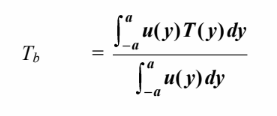
GIVEN
• Fully developed laminar flow between two flat plates
• Spacing = 2a & ?T/?x = C
• Bulk mean temperature as defined above
FIND
• Show that the Nusselt number based on the bulk mean temperature = 4.12
ASSUMPTION
• Steady state
• Constant and uniform property values
• Fluid temperature varies linearly with x (This corresponds to a constant heat flux boundary)
SKETCH

The solution will progress as follows
1. Derive the temperature distribution in the fluid.
2. Use the temperature distribution to obtain an expression for the bulk mean temperature.
3. Use the bulk mean temperature to derive the Nusselt number.
Beginning with the laminar flow energy equation of

v = component of the velocity in the Y direction = 0
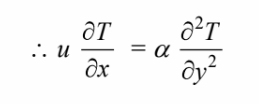
Note that ?T/?x = constant by assumption
The velocity profile u(y) must be substituted into this equation before the equation can be solved for
the temperature distribution. The velocity profile can be derived by considering a differential element
of fluid of width w as shown below

A force balance on this element yields

Since the flow is fully developed

Integrating with respect to y

This is subject to the following boundary conditions

This is subject to the following boundary conditions
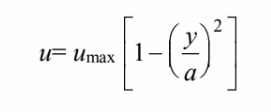
Substituting this into the energy equation
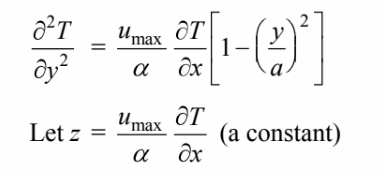
Subject to the boundary conditions


Applying the first boundary condition, C1 = 0
Integrating again

Applying the second boundary condition

Therefore, the temperature distribution is

The bulk mean temperature is defined as

Solving the numerator of this expression

The denominator is

The rate of heat transfer is given by

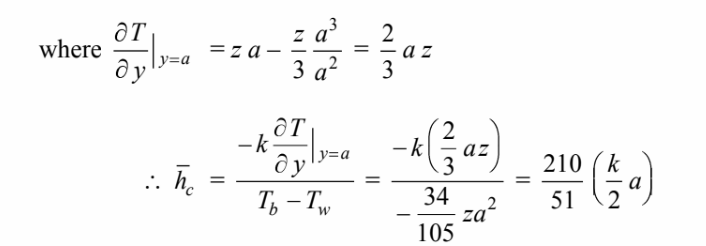
You might also like to view...
Lenz's Law: According to Lenz's law, the induced current in a circuit always flows to oppose the external magnetic field through the circuit.
A. True B. False
Double-Slit Interference: A pair of narrow slits that are 1.8 mm apart is illuminated by a monochromatic coherent light source. A fringe pattern is observed on a screen 4.8 m from the slits. If there are 5.0 bright fringes/cm on the screen, what is the wavelength of the monochromatic light?
A. 550 nm B. 600 nm C. 650 nm D. 700 nm E. 750 nm
A photon of wavelength 1.50 × 10-10 m is scattered at an angle of 90° in the Compton effect. The wavelength of the scattered photon is
A) 1.52 × 10-10 m B) 1.49 × 10-10 m C) 1.48 × 10-10 m D) 1.51 × 10-10 m E) 1.50 × 10-10 m
A 4 kilogram block of ice is removed from a freezer where its temperature was maintained at –20 degrees Celsius. How much heat does the ice absorb as it is warmed to –10 degrees? (The specific heat capacity of ice is 2,000 joules per kilogram degree Celsius.)